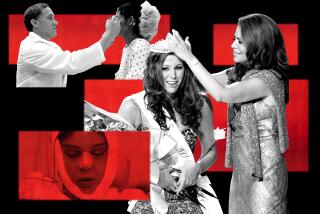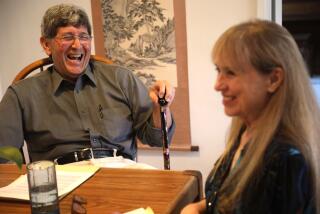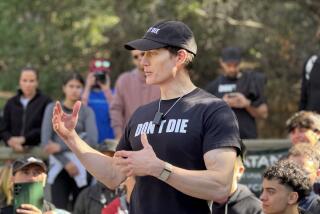Telling It Like It Is : Dr. Susan Love can be blunt, even sarcastic. But she treats her breast cancer patients with compassion, plain talk and gentle humor.
Thursday, 8:10 a.m.:
Lucy Johnson’s family is gathered around her bed outside Operating Room 2 at UCLA Hospital. In less than an hour, she will undergo major breast cancer surgery--lumpectomies on both breasts and the removal of several lymph nodes.
Johnson, 71, smiles at her husband, son and daughter-in-law as they talk in quiet, reassuring tones. But when she speaks, she starts to cry.
“I never thought this would happen to me,” Johnson says, her voice quivering.
Duane Johnson reaches to touch his wife of 29 years, but he can offer only love and moral support. Lucy Johnson has to trust her life to a woman she met only a few weeks ago.
Dr. Susan Love, dressed in surgical scrubs, bursts around the corner. “Where’s the star of this show?” she demands as she heads toward Lucy. The somber mood is broken. Everyone laughs.
There is no mistaking Dr. Love. This fast-talking, highly opinionated, funny woman with a name befitting an evangelist is probably the best-known breast cancer surgeon in the country.
Among her peers she is respected for her skills in the operating room and the research lab.
But that’s not why she’s famous. Love may be a high-powered surgeon, but she has won the devotion of her patients by spending hours with them, explaining their cancers and their treatment options in lay terms. Her name is spoken with awe on women’s health hot lines. “Dr. Susan Love’s Breast Book,” published two years ago, has become a bible for those with breast cancer.
Love, 44, came to Los Angeles this summer to be the founding director of the UCLA Breast Center, which officially opened last month. The center is designed to be a one-stop care unit with highly personalized patient services, the latest procedures, an extensive research agenda, experimental trials, student instruction, seminars for outside doctors and special clinics for a variety of breast conditions. It aims to be nothing less than the largest, most comprehensive and influential breast treatment facility in the world.
Despite her fame, Love was not an obvious choice for such a position in a prominent medical institution. Until now, she has been an outside agitator. And she has relished the role.
On “Nightline,” for example, Love railed against male doctors who advise healthy women in the high-risk profile for breast cancer to have their breasts removed. She suggested sarcastically that men with a high risk for testicular cancer get similar treatment.
“I mean, we could take testicles out and put Ping-Pong balls in their place and the men would never get testicular cancer,” she said.
Love liked the comment so much she repeated it in her book, which is dedicated to her female lover and the daughter they are raising together. And she certainly did not curb her tongue when testifying before Congress, as she has several times, about what she believes is a shameful lack of research funding for women’s health problems.
It’s not often that an outside agitator gets the chance to make changes from within, but Love is now in that position. She has gone from running a clinic in a small, private Boston hospital to overseeing the day-to-day operations of a highly visible new venture in a medical center with more mileage in corridors than the Pentagon.
And, at least at the beginning, Love is maintaining her trademark--an intimate bond with her patients.
She grasps Lucy’s hand and speaks quietly. “You know,” she says conspiratorially, “they can’t start anything without us.”
Lucy stops quivering. Her smile is radiant.
“It’s just you and me that count now,” Love continues. “And we have a date.”
*
8:49 a.m.:
Johnson, who is partially sedated, has been strapped onto the operating table and hooked up to monitors that track her breathing and heart functions.
Just before the anesthesiologist administers the propofol that will render Johnson unconscious, Love takes her hand one more time. “It’s when the level of fear is at its highest,” Love explains later. “That’s when I make my pact with them.”
The anesthesia begins to run into Johnson’s veins. Perhaps the last thing she hears is, “Just have a good sleep now. Before you know it, it will be all over.
“I’m going to take good care of you.”
*
Susan Love was born in Long Branch, N.J., but when she was a young girl her family moved to Puerto Rico and then Mexico, for her father’s business. She decided to become a doctor while attending a Roman Catholic junior high school in Mexico City.
“I had this wonderful nun as a biology teacher,” Love said during an interview at her Brentwood home several days before Lucy Johnson’s surgery. “She got me interested in science.”
Love was not only determined to go into medicine but to do it as a nun. She entered a convent while studying pre-med at Notre-Dame of Maryland. “It was the ‘60s and everyone was being relevant,” Love said. “I thought the way to save my soul was to save other people, but the nuns were more into sitting in the chapel, meditating, to save their souls.”
She cut her ties with the convent but not her social consciousness. While finishing her undergraduate degree at Fordham University, she organized and ran a South Bronx, N.Y., social services center. During summers she worked for the Red Cross, teaching first aid and baby care in Central America.
Love attended medical school at Downstate Medical Center in Brooklyn, N.Y., and eventually chose to become a surgeon because she liked a hands-on, pragmatic approach to solving problems. “I liked the idea that you could get in there and fix something,” she said.
Finally out on her own in 1980, after residency at a Harvard-affiliated hospital, she sought to establish a general surgery practice in Boston. One of only a handful of female surgeons in the city, Love was determined not to be pigeonholed as a “women’s doctor.”
“A friend of mine,” she said, “remembers me saying, ‘I’m not going to let them make me into a breast surgeon.’ ”
*
9:38: The first lumpectomy is complete and Love begins to sew up the incision.
Most surgeons sew the breast so that it might be slightly smaller, with no dent. Love uses a method that might leave a slight dent.
“We surveyed women in Boston and they told us they would rather have a dent than a difference in size,” Love tells Kevin Armstrong, the resident assisting her. “It’s difficult to buy a bra, to buy clothes if the breasts are not the same size.”
She smiles at Armstrong.
“It takes a woman to realize something like that,” Love says.
Despite her determination to be treated like any other general surgeon in Boston, most of Love’s early referrals from other doctors were women. And most had breast problems.
Eventually, she changed her view of women’s doctors. “I saw that breast problems was an area where I could make a real difference,” she said in the interview.
Her new vocation satisfied her need to save the world and her love of hands-on science and personal interaction.
“The people who go into surgery are not necessarily the people who like to sit and listen,” Love said. “I once had a chief of surgery tell me, ‘The trouble with breast surgery is that the talk-to-cut ratio is all wrong. You have to talk too much to the patient for the amount of cutting you get to do.’ ”
*
10:01: After a change of sterile gowns and instruments to prevent contamination, Love begins the second part of the surgery, the removal of about 10 lymph nodes on Johnson’s right side.
They will be examined later for cancer cells. If they are found, Johnson will have a course of chemo- or hormonal therapy, plus radiation, in the weeks after surgery. Love had explained these scenarios to Johnson before the operation.
One of Love’s recent visitors at UCLA was a Los Angeles schoolteacher who came for a second opinion. After looking through her pathology reports and X-rays, Love confirmed that the woman needed a mastectomy.
But Love disagreed that the operation had to be done in the next few days. “The idea that you have to rush into this is not right,” Love told the teacher.
Breast cancer is the one of the slowest-growing of cancers, Love said, rarely requiring emergency treatment. She recommended that the woman take a few days to consider her options and prepare emotionally. “Frankly, I don’t think you are quite ready,” Love said. “You might consider calling your doctor and postponing for a week or so.”
The teacher asked for the postponement but was told that if she did not keep the reserved appointment, her surgeon would not see her again.
He didn’t. The teacher had her surgery done at UCLA by Love.
In her hospital room the day after surgery, the teacher was still angry. “I will never again put up with a doctor treating me like a small child,” she said.
*
10:54: Part three of the surgery on Johnson begins. Besides the cancer found in her right breast, some precancerous cells--which turn into cancer 30% of the time-- had been found in her left breast. Love does a small lumpectomy on this side, removing the cells.
In 1990, Michael Zinner, chief of general surgery at UCLA, first saw Susan Love, who by then had founded the Faulkner Breast Clinic in Boston, on television. “I was on a trip someplace and was watching the ‘MacNeil/Lehrer Report’ in the hotel room,” he said, “and she was on, talking about women’s health issues. I was impressed with her dedication to the field, with her straightforward, honest approach.”
A year later, when Zinner and other staff members started to plan the breast center, he contacted her. The negotiations between Love and the medical center took almost a year. She wanted--and got--a substantial commitment to research. Zinner wanted to make sure Love would fit into a highly visible, bureaucratic setting.
“At UCLA she represents an institution, and what she says reflects on all of us,” Zinner said. “I don’t for one second expect to ever restrain her from speaking out on her views. But she is speaking from a different platform now.”
The subject of Love’s sexual orientation, Zinner said, came up only in discussions about benefits. “We decided it was a recruitment like any other recruitment,” he said. “We addressed her family’s needs in moving here--getting her daughter into one of the UCLA preschools, health benefits.”
Love’s companion is Helen Cooksey, also a surgeon, whom she had known since medical school. “I was always a bit nervous around her,” said Love, who was still in the closet when she met Cooksey.
“I had this fear that it was catching and as it turned out,” Love said with a laugh, “I was right.”
They have been together for 10 years. Six years ago they decided to raise a child, but Cooksey’s attempts to become pregnant through artificial insemination proved unsuccessful.
Then Love tried. “Being a good Irish Catholic,” Love said, “I got pregnant on the first attempt.”
Their daughter, Kate, was born four years ago.
After the move to Los Angeles, Cooksey elected to take time off to help Kate settle into a new city. Love routinely takes their daughter to school in the morning.
“It’s the most stressful part of my day,” Love said. “My daughter is a dawdler in the morning. Just getting her ready for school and out the door is a struggle.”
Love believes her openness about her homosexuality helps discourage disparaging comments.
But some UCLA doctors, according to nurses who work with Love, did raise the issue before she arrived. “One of them said, ‘I don’t know if women will really want to be examined by her,’ ” a nurse said.
“Of course, he is a male and could not see any reason why women might feel the same way about him.”
Women have certainly not shied away from seeing Love. They have come to the new center from as far away as New York. And there is a three-week wait to get an appointment.
*
11:32: Love is sewing up the cut she made on Johnson’s right breast. The operation is nearly over.
“Soon we can turn her into a person again,” she says.
There is no mistaking that Love is in her element in the operating room. But she says one of her greatest hopes is that, within her lifetime, this kind of operation will cease to exist.
“The way we treat breast cancer now--surgery, radiology, chemo--it’s so crude, primitive,” she says. “The real answers will come from molecular biology. That’s where we will find the real cause of this disease and figure out how to deal with it.
“By the time I retire, I hope I am out of a job.”
Love waits until Johnson, emerging from the anesthesia, can respond to simple commands. Then she finds the family in a waiting room.
“Everything is fine. It went great, very smoothly,” she says quickly. “I had to take out a little more on one side than we had planned, but that was no problem at all.”
In later lab tests, cancer cells were found in a couple of Johnson’s lymph nodes. After radiation she will undergo hormonal therapy. Because cancer was found in so few cells, Johnson has an 80% chance of living at least five more years, according to recent research.
“There were no surprises,” Love says to the family, then, turning directly to Duane: “She will have scars when she is laying down but it’s OK as long as you don’t put mirrors on the ceiling.”
He laughs and shakes his head. Love takes his hand.
“It went very smoothly,” she repeats. “I think there is hope.”
More to Read
Sign up for Essential California
The most important California stories and recommendations in your inbox every morning.
You may occasionally receive promotional content from the Los Angeles Times.











